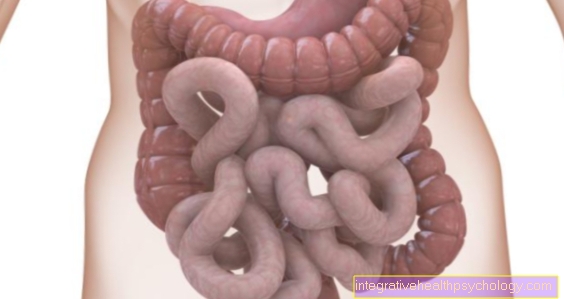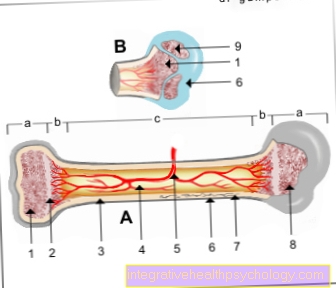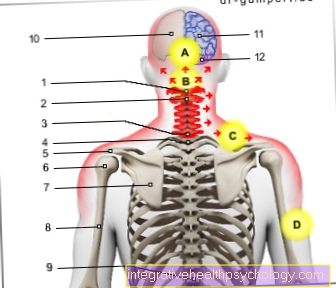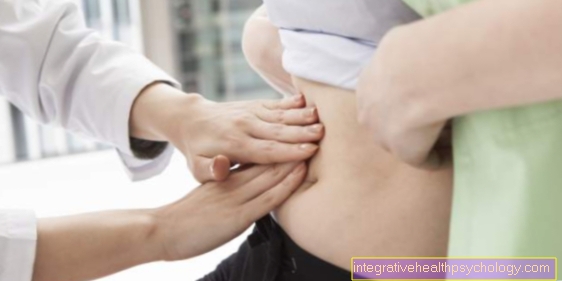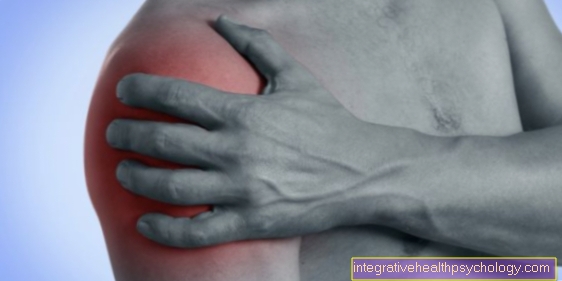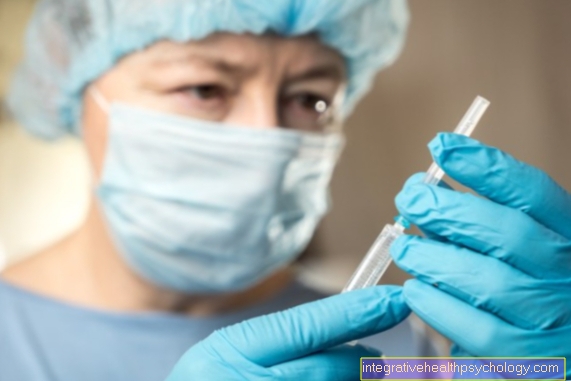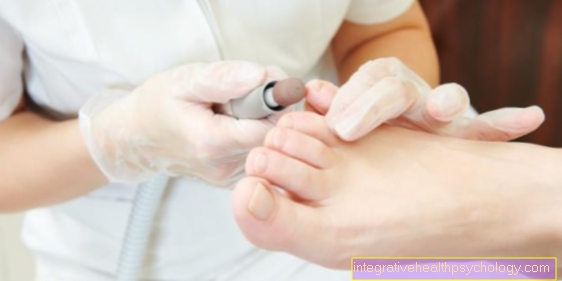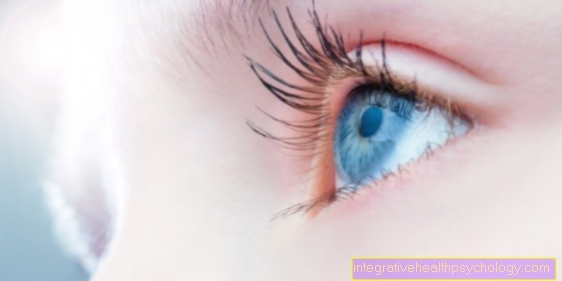The bellybutton
introduction
The navel is a rounded indentation that lies roughly in the middle of the abdomen. In medical terminology, it is the belly button Umbilicus called. It is a scarred remnant of the umbilical cord that connects the fetus to the mother during pregnancy.
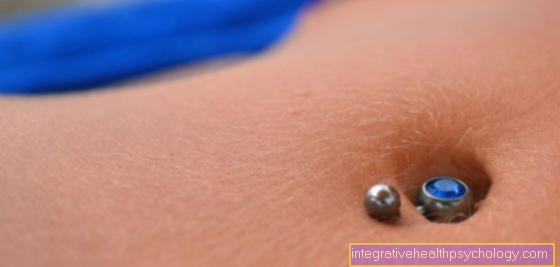
Anatomy of the navel
The belly button is what remains of the umbilical cord created during pregnancy even after the birth. The umbilical cord supplies the baby with oxygen and nutrients until it is born. At birth, this is pinched off and cut off. What remains is a stump which regresses within several days to a few weeks and finally falls off. The navel consists of connective tissue that is covered by the so-called "papilla". The papilla is the inwardly curved remainder of the umbilical cord. The scar and papilla are also surrounded by an umbilical ring.
There are roughly two forms of the navel. The more common concave, inward-looking and the convex navel turned outwards. In overweight people, the belly button often has a deep, slit-like shape. The navel roughly divides the abdomen into four quadrants, which are used in medicine for rough orientation and localization. Its function is completed with the end of the birth process, which is why the navel in adults only takes on an optical role.
Function of the belly button
For adults, the navel no longer has a function, but is actually nothing more than a scar, which at most can cause problems through certain diseases.
The navel is the pitted remnant of the umbilical cord that connects the fetus to the mother's placenta during pregnancy.
The placenta, also known as placenta, develops from the lining of the uterus and consists of a maternal and a child's part.
Figuratively speaking, the maternal part of the placenta is a pot that contains maternal blood. The fetal part represents the matching pot lid. The pot lid is connected to the umbilical cord and above it to the child.
The exchange of substances can take place through the contact of the child's tissue with the mother's blood. This means that the child takes everything it needs from the mother's blood, namely oxygen and nutrients, and gives off carbon dioxide and other waste products back to the mother.
After birth, however, the placenta becomes superfluous as the infant can now breathe and dispose of its waste products such as carbon dioxide and urea.
Therefore, the umbilical cord between mother and child is cut, the remnants of the umbilical cord recede and leave the navel as a scar.
Diagnostics on the navel
In the course of life, illnesses or injuries can occur on the belly button. In addition to diseases, there are also Anomalies, which are congenital deviations from the norm. The term includes minor malformations that generally have no disease value. These include, for example Amnion-and the Flesh navel.
At the Amniotic navel the amniotic cover extends over the abdominal skin. This creates a skin defect that usually heals without complications. The amnion is the innermost Egg skin and thus part of the Amniotic sac.
At the Flesh navel exactly the opposite occurs. The umbilical cord is covered with abdominal skin, so that after the umbilical cord regresses, a blunt-shaped umbilicus is formed, which protrudes a little above the level of the skin.
In addition to the umbilical abnormalities, there may be too Injuries or. Bleeding of the belly button. This can occur especially in infancy after the umbilical cord has been cut. Usually they are not particularly strong and therefore also not dangerous. In rare cases, however, heavier bleeding may occur, but this is usually general Bleeding tendency in the case of infections (e.g. with a Blood poisoning), or the infant has a coagulation disorder such as Vitamin Kdefect.
There are also others from the Embryonic development emerging malformations, usually shortly after birth to be established. This includes the Umbilical cord break (Omphalocele), the Urachus-and Umbilical fistula as well as the Umbilical hernia, which can, however, also occur in adults. The omphalocele is usually in before birth Ultrasonic visible, a urachus fistula can also be visualized sonographically (with ultrasound). Umbilical fistulas are best in the roentgen to see.
Many diseases can also be associated with childhood red spots on the navel accompanied.
Why do you have a belly button?

As already mentioned above, the umbilical cord break, the urachus and umbilical fistula can be traced back to the embryonic development.
An umbilical cord break is a hernia, a rupture of the viscera that occurs at the base of the umbilical cord between the 4th and 10th week of pregnancy. During this time, a physiological umbilical hernia takes place in the embryo, i.e. one corresponding to normal life processes. The reason for this is that the intestine grows so quickly during development that it no longer has enough space in the abdomen of the fetus and escapes outwards into the amniotic sac. This break usually disappears by the 10th week of pregnancy. If this is not the case, one speaks of one Omphalocele or a broken umbilical cord. This means that internal organs such as the intestines, stomach or liver pass through the abdominal wall to the outside.
During development in the womb, in addition to the umbilical cord, other connections are formed which serve to supply the embryo and which, however, recede after birth because they are no longer needed. They therefore actually do not play a role - unless they are incompletely or incorrectly regressed. One of these connections is the yolk duct, which connects the yolk sac to the intestine. This yolk duct (ductus omphaloentericus) runs from the navel to the intestine. If this duct is not completely regressed in the area of the umbilicus, an umbilical fistula develops. Insufficient regression in the area of the intestine leads to what is known as a Meckel's diverticulum.
Another embryonic gait is that Urachus, the urethra. This connects the urinary bladder with the brook navel. This means that the embryo releases its urine through this passage via the navel. The urachus normally atrophies after birth; if it does not, a urachus fistula can develop.
But enough of the embryonic ducts and connections, diseases of the navel can also occur in adults. The most important one is the umbilical hernia. This is a hernia, but it can also occur in babies, especially if the baby is premature. Furthermore, it can also lead to inflammation of the navel in babies and toddlers.
In adults, women are more often affected than men because they have more risk factors. These include obesity (obesity), water in the stomach (Ascites), which is a chronic pressure load on the abdominal wall. Furthermore, heavy physical exertion and (past) pregnancies are factors that can contribute to the development of an umbilical hernia.
What are the symptoms of diseases of the belly button?
With a complete umbilical fistula (yolk duct not receded at all), intestinal contents can be secreted through the navel. In the case of an incomplete fistula, the duct is only partially present, which means that inflammation occurs, but intestinal contents do not leak.
Since there is a connection between the urinary bladder and the scar in the urachal fistula, the result is a constantly oozing navel. The opening also brings with it a certain risk of infection, which can manifest itself in recurring inflammation.
With an umbilical hernia, severe pain occurs in the immediate vicinity of the umbilicus, which often leads to a doctor's visit. In addition, there may be redness and swelling or bulging of the navel.
In the case of an inflammation of the belly button in the child and also in the baby, the main thing is redness and swelling of the navel and the surrounding tissue. Another typical indication of inflammation of the belly button is a leaking pus.
Pain in the navel
Belly button pain can have many different causes.
In children, for example, harmless growth pains come into consideration, but pathological processes in the abdomen, such as appendicitis or an umbilical hernia, can also cause pain in the navel.
Read more on the topic: Pain in the belly button
Diseases of the belly button
Although the navel has no function in humans, it is not entirely meaningless. There are a number of medically relevant diseases that usually require treatment or can even be dangerous. In addition to diseases of the navel, there are also so-called navel anomalies, which, however, usually heal without complications. These include the amniotic umbilicus and the skin or flesh navel.
A common complication of the navel is the umbilical hernia, which occurs mainly in newborns (Omphalocele), but can also affect adults.
Furthermore, a lack of regression of some of the structures present in the fetus can lead to an "urachus fistula" or an open yolk duct (Omphaloenteric duct) being able to lead. With these malformations, urine or intestinal contents can leak out of the navel.
Other common diseases of the belly button are umbilical bleeding and inflammation (Omphalitis), which, however, mainly occur in babies.
Read more on the topic: Pus in / out of the navel
Inflammation of the baby's belly button
The inflammation of the navel in babies, also called "Omphalitis“Is a complication that usually occurs during regression or shortly after the umbilical cord has been severed. This leads to an inflammation, usually bacterial, of the not yet healed navel stump. The first symptoms of omphalitis are redness, swelling, soreness, and increased purulent discharge from the navel.
Omphalitis is usually recognized early and usually treated with antibiotics. Surgical rehabilitation may be necessary in the case of more severe courses. Without early treatment and in severe infections, omphalitis can spread to the bloodstream and trigger systemic inflammation. This can lead to a high fever, increased heart rate, decreased blood pressure, weakness and fatigue, and confusion. If left untreated, omphalitis can be dangerous for the newborn, which is why complications and severe courses often occur, especially in developing countries.
Read more on this: Inflammation of the belly button in the baby
Inflammation of the belly button in adults
Inflammation of the belly button in adults is relatively rare, as it usually has to come from outside influence, which penetrates or opens the natural barrier of the skin. This is often done by applying one or more piercings (see also: Navel piercing). It is therefore advisable to watch his belly button after such an operation in order to be able to react in the event of an inflammation. Developmental malformations, an inflamed umbilical hernia or poor hygiene are another possibility for inflammation in adulthood.
Read more on the subject: Inflammation of the belly button in adults
Discharge of pus from the navel
A discharge of pus from the belly button or a purulent layer are common symptoms when removing the umbilical cord in newborns (Reformation of the umbilical cord). A small amount of pus is usually normal and does not need treatment. However, the remnant of the umbilicus should be closely monitored and appropriately cared for. However, if a lot of pus emerges or if there are other symptoms in addition to pus, such as redness, pain, fever or swelling, a doctor should be consulted, as it could be an inflammation of the belly button, which must be treated.
You might also be interested in: Complications during childbirth
Pulling in the navel
Pulling in or around the belly button is a very unspecific symptom and can have many causes. Mostly it is a harmless occurrence that can happen from time to time. However, if the pulling persists for a long time or if the pulling is very strong or worsening, it may be due to illnesses that require treatment. It is also important to pay attention to other symptoms that are present at the same time, such as nausea, pain, diarrhea, dizziness and the like, as these can give an important clue to an underlying cause. For example, if there is constant pulling in connection with a swelling or external change in the navel, this can indicate an umbilical hernia.
Umbilical hernia
An umbilical hernia or "Umbilical hernia"Or for infants"Omphalocele“Called is a common phenomenon in which there is a weakness or a yielding of the muscles surrounding the navel with subsequent entry of abdominal contents into the navel. Babies are affected much more often because the abdominal muscles have not yet achieved full strength and the umbilical ring subsides more easily as a result. In babies, the navel bulges into the remaining umbilical cord (Omphalocele). In children and adults, umbilical hernias are either congenital or develop due to increased pressure in the abdomen.
Connective tissue weakness is another risk factor for umbilical hernias. The combination of increased pressure in the abdomen and a weak point in the abdominal muscles, which is the navel, for example, leads to a bulging of the abdominal contents. These are mostly intestinal loops, which are then also called "hernial sac", but can also be abdominal organs, which is a more complicated process. While umbilical hernias often resolve on their own in newborns, a surgical procedure to stabilize the abdominal wall usually has to be carried out in adolescents or adults.
Read more on the subject: Umbilical hernia
Belly button stinks - what's behind it?
A smelly belly button can have many causes. The most common cause is poor hygiene. Since the belly button is often turned inwards, it offers a perfect nutrient base for bacteria and fungi. Bacteria love a moist and warm surface, which a navel presents to them in their hand. Therefore, if you have a smelly navel, you should definitely have adequate hygiene.
Another common reason for a bad smelling navel are so-called "omphaliths". Omphaliths are navel stones that are formed over time by the pressing together of dead and fallen skin flakes. Belly button stones usually appear brownish and are mainly located in the narrow, deep areas of the navel. They are often difficult to extract. In this case, it can be helpful to use a cotton swab to cleanse the belly button on a regular basis.
Other causes can be skin rashes, psoriasis or contact allergies. Contact allergies often arise from piercings or from tight-fitting, irritating clothing.
In addition to the harmless and often hygiene-related causes, an umbilical malformation can also be the cause of the odor. In this case, in addition to the smell, there is often leakage of liquid, a so-called weeping navel.
Read more on the subject: Belly button stinks - what's behind it?
Belly button is bleeding - what to do?
The causes of a bleeding navel are usually small inflammations or injuries within the navel. This can be, for example, a small inflammation, a pimple or an insect bite. A closer inspection of the belly button can be very helpful at this point. More bleeding or additional pus and pain may indicate more inflammation or an abscess. Post-bleeding often occurs after a piercing or other foreign material has been introduced. These are usually associated with a minor inflammation and often heal on their own.
If, in addition to bleeding, there is leakage of fluid and a bad smell, this could also be due to an umbilical malformation. If there is additional swelling and changes in the shape of the navel, caution is advised, as an umbilical hernia could be hidden behind it. In the case of newborns, on the other hand, bleeding from the umbilical remnant occurs very often, some of which can bleed very heavily and for a long time. This is a common phenomenon that is usually self-limiting and does not require treatment. In any case, a doctor should be consulted in the case of a bleeding navel in order to get to the bottom of the cause, to eliminate it and to avoid a recurrence in the future.
Read more on the subject: Belly button is bleeding - what could be behind it?
Endometriosis
Endometriosis is a disease in which the lining of the uterus outside the uterus causes regular, cycle-dependent, severe pain and bleeding. In "extragenital endometriosis" the symptoms appear in areas that have no connection with the genital organs. In rare cases, endometriosis of the belly button can also occur. An indication of this would be the occurrence of severe cycle pain in addition to the pain in the belly button.
Navel wet - is that dangerous?
An oozing navel can be an indication of an embryonic malformation. For example, there may be a remaining connection between the bladder and the navel (Urachus fistula). This leads to constant, uncontrollable oozing from the navel. Another malformation is the so-called persistent yolk duct (persistent ductus omphaloentericus). There has been a connection between the small intestine and the belly button that has existed since the embryonic period and has not completely receded in the course of development. Liquid intestinal contents leak out of the navel. However, if a navel is wet for the first time and has been normal so far, it is more likely that there is a small bacterial inflammation or a fungal infection.
Belly button lint - how is it created?
Belly button lint has long been an unexplained, mysterious phenomenon. But since 2001, based on a study, we have known what exactly they are and where they come from. Belly button lint consists mainly of textile fibers, but also of dust, hair cells and hair. They are mainly caused by the rubbing of the stomach hair on the clothing and are then also transported through the hair to the navel, where they increase in size. Those who use a concave (curved inward) Belly button and especially a lot of long belly hair. In addition, the number of lint increases with age and also increases with increased physical activity.
Lint is more common in winter as more clothing is worn. Accordingly, women generally have less lint. The average color of the lint is blue-gray and in the meantime world records have even been set for collecting navel lint.
In summary, it can be said: navel lint is completely normal and absolutely without any disease value! However, for personal hygiene and to prevent bacterial inflammation, it can be helpful to remove the lint and clean the belly button.
Red spots around the navel
There are several reasons for red spots or rashes on and around the belly button. The most common cause is local reactions to certain stimuli. For example, a shave of the abdominal hair, a contact allergy, an inflammation, an insect bite or a bite could be the reason. Other possibilities, especially if the rash appears all over the abdomen or in other places, are systemic diseases such as infections, herpes viruses (e.g. shingles), Allergies, fungi, psoriasis, measles, chickenpox, rubella, neurodermatitis, scarlet fever or autoimmune diseases.
Abscess in the navel
In the case of an abscess, a local inflammation occurs, usually caused by bacteria, which penetrates into the depths and creates an artificial cavity there. Since the belly button is a suitable place for bacteria to reproduce, it is not uncommon for belly button abscesses to occur. Within the inflammation, the body's own defense cells penetrate, which try to fight the pathogen, which creates pus. The increased production of pus leads to a painful swelling, which can often be seen as a bulge under the skin. Since the abscess is usually very deep in the skin and usually does not heal by itself, surgical "abscess dissection" is almost always necessary.
How are diseases of the belly button treated?
All problems of the umbilicus can be successfully treated and thus eliminated by means of surgery. If the umbilical cord breaks, it should be noted that the birth takes place by means of a caesarean section in order to prevent the contents of the break from rupturing and thus a very dangerous situation. An operation should then be performed as early as possible so that the contents of the hernia can be returned to the intestine and the abdominal wall can be closed.
An umbilical hernia is treated in a similar way. As a rule, it can only be controlled with an operation because adhesions in the umbilical region make it difficult to reposition the leaked intestine and because there is a risk of the intestine piece being trapped. Firstly, this is very painful and secondly, the intestine can die at this point, which is a very dangerous situation. This operation is a minor procedure that does not necessarily require general anesthesia and can be performed on an outpatient basis. An umbilical fistula must also be surgically cut out, otherwise recurring inflammation can occur. In the presence of a uracheal fistula, surgical removal is urgently recommended, as there is a permanent risk of inflammation and a high risk of malignant degeneration, i.e. the development of cancer.
Belly button itches - is that a sign of pregnancy?
An itchy belly button is a common symptom during pregnancy. However, the itching is caused by the increased tension in the skin, which in turn only occurs when the abdominal girth is significantly increased. The probability that an itchy belly button indicates pregnancy is very low, as this would already be known. Only an itchy navel would be more indicative of a rash, allergy, insect bite, inflammation or umbilical hernia. However, if you are pregnant, regular application of lotion to the belly will help with an itchy navel.
You might also be interested in the following article: Umbilical hernia during pregnancy.
Recommendations from the editorial team on the subject of the navel:
Here you can find out everything you need to know about the navel topic:
- Belly button stinks - what's behind it?
- Inflammation of the belly button
- Pain in the navel
- Inflammation of the belly button in the baby
- Inflammation of the abdomen in the child


.jpg)




